Yet before the food or drink even makes it that far, the tasting process has already begun. The olfactory sensory neurons in your nose have already started firing off signals to your brain to identify the smell. Pleasant? Not-so-pleasant? Does it inspire feelings or specific memories?
The second the food or drink is consumed, it’s time for the 8,000 or so taste buds to get to work. Simultaneously, two cranial nerves, one at the front of the tongue and one at the back, begin sending messages of their own to the brain. This precisely orchestrated conversation between your nose, mouth, and brain is called Neurogastronomy, the science of taste perception. A lot is happening behind the scenes while we’re enjoying our meals!
There is also an evolutionary component to our taste perception. While salt and sugar are necessary for biological function and energy production, tastes like bitter and sour inherently meant underripe, spoiled, or even DANGER!
But as we evolved, so did our palates. People have been increasingly adventurous in the flavor profiles they want in their food and drink. Take craft beer for example. Once considered “beer spoilage microorganisms”, strains such as Pediococcus and Lactobacillus are now sought after to create the traits that make a good, sour beer. There are several ways brewmasters go about crafting a sour, most requiring the injection of these Lactic Acid Bacteria (LAB) at some point in the beer making process.
Our latest Barrel Aged Brew, Honey Barrel Brown, was aged for 518 days in a Bourbon barrel from now defunct Fox River Distilling out of Geneva. This barrel, as many do, inherently had LAB present. Therefore, the honey added to the brew promoted the production of lactic acid within the beer, resulting in a stark tartness or sour taste, which is then offset by the sweetness of the honey. It is a very complex beer with many layers of flavors. So give a snifter a try and practice a little Neurogastronomy.

